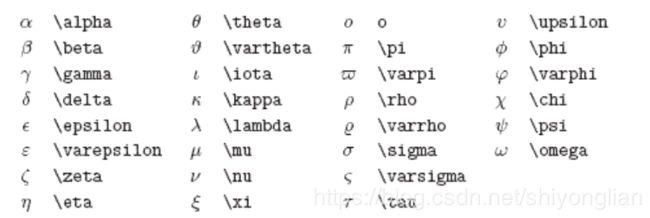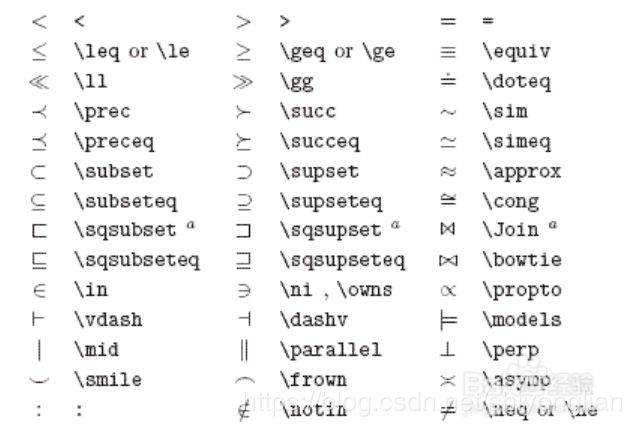LaTex使用技巧
文章目录
- @[toc]
- 论文排版工具LaTeX
- 该段转载至
- 1. 文本/排版:
- 二、公式编辑(2-8均是在1的条件下使用):
- 三、插入图片:
- 四、插入表格:
- 五、参考文献:
- LaTex常用技巧
- 特殊字符的添加
- 字母上面的上标输入方法
- 二元关系符的表达方式
- 二元运算符的表达方式
- 大尺寸运算符的表达方式
- 定界符的表达方式
- 小写希腊字母的输入方法
- 大写希腊字母的输入方法
- 插入表格
文章目录
- @[toc]
- 论文排版工具LaTeX
- 该段转载至
- 1. 文本/排版:
- 二、公式编辑(2-8均是在1的条件下使用):
- 三、插入图片:
- 四、插入表格:
- 五、参考文献:
- LaTex常用技巧
- 特殊字符的添加
- 字母上面的上标输入方法
- 二元关系符的表达方式
- 二元运算符的表达方式
- 大尺寸运算符的表达方式
- 定界符的表达方式
- 小写希腊字母的输入方法
- 大写希腊字母的输入方法
- 插入表格
最初使用LaTex是应为投稿的论文只给了LaTex的模板,并没有给Word模板,被逼无奈学的LaTex。不过后面发现使用LaTex进行排版的论文效果是真的漂亮,无论是表格还是字体都无可挑剔。但是LaTex的官方文档使用说明不太详细,在查找指令的过程中浪费了很多时间,为了师弟师妹们可以更加快速轻松的驾驭LaTex,无忧进行论文排版,写了这篇博客。
论文排版工具LaTeX
科研论文以及毕业论文编写完成之后,格式的调整以及排版是最让人头疼的,但是使用LaTeX进行排版就没有这些烦恼。LaTeX的使用有两种方式,
(1) 下载LaTeX的安装包自己线下安装使用(WinEdt),这种方法的优点是不需要联网,可以离线操作,缺点是不能实时查看编译结果
(2) 登陆 overleaf网站 在线编写LaTeX,该方法的优点是不用下载安装软件,且可以实时查看编译结果,在左边编辑右边就能看见结果;最后写好的LaTeX的包也可以下载保存;上面还有毕业论文、简历、项目报告等的LaTeX模板;唯一缺点是需要联网
网站首页如下图
该段转载至
低端绅士的博客内容如下
Overleaf是一个使用LaTeX进行多人协同编辑的平台,可以免费注册和使用,不用下载LaTeX软件,是最为著名的LaTeX在线协作系统。主要特色是有LaTeX插件,编辑功能十分完善,有实时预览(即编即看,无需手动编译)的功能。科研工作者可以在各大期刊的网站上下载到其Overleaf模板,进行论文写作(不同模板的排版方式(比如“作者”和“地址”)的格式不同)。在注册Overleaf后会有详细的指引,在此不再赘述,平台是纯英文的,需要使用者适应,这也是科研工作者的必备素质。
Overleaf开发界面
1. 文本/排版:
1、定版型:
documentclass [A] {B}
A:
①字体10pt(默认值),11pt,12pt,例子:\documentclass[11pt]{article};
②纸张大小有几个,最常见的就是a4paper,letterpaper(默认值),例子:\documentclass[a4paper]{article};
③单双面oneside(article,report默认值),twoside(book默认值),例子:\documentclass[twoside]{article};
④组合实现:\documentclass[a4paper,twoside,11pt]{article}顺序随意;
B:
①常用:Article(英文科研文章)/report/book;②ctex文档类(支持中文):ctexart/ctexrep/ctexbook;
2、加标题/日期/作者:
在\begin{document}之前输入:\title{标题}\author{作者}\date{日期} ; %输入空格即为空
在\begin{document}之前输入:\maketitle ; %输入后,前三者才生效
3、修改页边距:
\Usepackage{ geometry };
\Gemometry(left=2.54cm,rught=2.54cm,top=3.09cm,bottom=3.09cm); %A4版上下为 2.54厘米;左右为 3.09厘米
4、文本加粗: \textbf{ };
5、左对齐: \noindent; %本行左对齐不缩进
6、换行: \newline或者 \\;
7、空格: 单格\quad双格\\quad;
8、居中/左对齐/右对齐:
①部分居中:
\centering; %小范围内(比如表格)居中后面部分内容
②全部居中/左对齐/右对齐:
\begin{center/flushleft/flushright}要居中的内容\end{center/flushleft/flushright };
二、公式编辑(2-8均是在1的条件下使用):
1、
(1)行中插入公式: 公 式 公式 公式,例子: L 4 2 + L 3 6 − 4 L 3 \frac{L^4}{2}+\frac{L^3}{6}-\frac{4L}{3} 2L4+6L3−34L;
(2)行间插入公式(自动带上公式标号),\begin{equation}公式\end{equation},
\begin{equation}
\frac{L^4}{2}+\frac{L^3}{6}-\frac{4L}{3}
\end{equation}
2、粗体(向量或矩阵):用 \mathbf{}(有时 \textbf{}仍然有用);
3、上标:字母^上标;下标:字母_下标;可以参考上面公式的写法
4、括号:\left(括号内容 \right)或者直接输入();
5、分数:\frac{分子}{分母};可以参考上面的公式
6、求和:\sum_{下标}^{上标};
7、符号(求余符号为%):
(1)希腊字母:
(2)基本运算符:
(3)积分运算符:
三、插入图片:
1、首先将需要插入的图片上传到当前编辑文件的云端库中;
2、其次开始编程:
\usepackage{graphicx} %加入头文件
\begin{figure}[!htpb]/[H] %[htbp]是自动排版;[H]固定位置
\centering %图片居中
\includegraphics[scale=0.3]/[width=4.5in]{DPBS.png} %设置大小和名称
\caption{DPBS}\label{1} %图片名称和图片标号
\end{figure} %结束
其中,{figure}的可选参数[!htbp]:
h 代表here,将表格排在当前文字位置 ;
t 表示将表格放在下一页的top (页首);
p 表示p-page-of-its-own;
b 表示将表格放在当前页的 bottom(底部);!表示忽略美观因素,尽可能按照参数指定的方式来处理图片浮动位置;
四、插入表格:
1、粗线(表格的第一根线和最后一根线比表格中的横线更粗一些):
\usepackage{booktabs}
\toprule %第一根线
\midrule %中间的线
\bottomrule %最后一根线
2、调整位置:
\begin{table}[!htbp]
.......
\end{table}
其中,{table}有若干可选参数[!htbp]
h 代表here,将表格排在当前文字位置 ;t表示将表格放在下一页的 top (页首) ;p表示p-page-of-its-own;
b 表示将表格放在当前页的 bottom (底部) ;!表示忽略美观因素,尽可能按照参数指定的方式来处理表格浮动位置;
3、居中:
长度不长时\centering
长度过长时\centerline{} %把tabular的所有内容放进去
4、制表:
\begin{tabular}{|l |c | r |} %“|”表示竖线,“l/c/r”表示格内居左/中/右,
A & B & C\\ %“&”分隔不同列内的内容,“\\”表示换行
E & F & G\\
\end{tabular}
5、标签和名称:\label{label}\caption{name}
6、普通线:\hline或\cline{2-5} %后者可以画如下图这种表格:

7、行高:
\renewcommand\arraystretch{2} %表格行高设置为默认的2倍
五、参考文献:
1、格式:
(1)期刊:作者名.题目.期刊(缩写,斜体)年份(加粗),卷(斜体),页码.
(2)会议:作者名.题目.会议名称(不缩写,斜体),年份(不加粗);pp. 页码.
2、函数:
\begin{thebibliography}{}
\bibitem{ref label}
内容 %{\em要斜体的内容} {\bf要加粗的内容}
\end{thebibliography}
3、例子:
(2)代码:
\begin{thebibliography}{}
\bibitem{ref 1 }
Li, J.; Bioucas-Dias, J.M.; Plaza, A. Spectral–spatial hyperspectral image segmentation using subspace multinomial
logistic regression and Markov random fields. {\em IEEE Trans. Geosci. Remote Sens.} {\bf 2012}, {\em 50}, 809-823.
\end{thebibliography}
六、引用:(label是为了方便之后直接引用):
1、参考文献加label:在命令\bibitem写{ref A }
引用:\cite{ref A }
2、表格/图片加label:\label{ A }
引用:??????
七、笔者的实例:
1、效果图:
2、代码:
\documentclass{article} %英文科研文献常用类型
\usepackage{geometry} %更改页边距所需
\usepackage{graphicx} %插入图片所需
\usepackage{booktabs} %表格线条加粗所需
\geometry{left=2.54cm,right=2.54cm,top=1.0cm,bottom=1.0cm} %更改页边距
\begin{document} %开始正文
I'll create \textbf{a table with some formulas} and insert \textbf{a picture made by Visio}.
\newline\newline %换行
\noindent\textbf{1.Table.}\newline %加粗左对齐显示标题
\begin{table}[!htbp] %开始制表
\label{1.1}\caption{DPBS's Algorithm} %加标签和名称
\\ %换行
\centerline{ %表格居中开始
\begin{tabular}{ l } %构造只有一列的左对齐的表格
\toprule %第一条粗线
\textbf{Algorithm 1 }The deep pipelined background statistics (DPBS) target detection CEM algorithm\\ %第一行标题
\midrule %中间普通粗细的线
\textbf{Input: }Initialize the following parameters.\\ %以下为第二条线和第三条线之间的内容
(1)HSI data size: $W\times H\times L=N\times L$;\\
(2)the value of $\beta$;\\
(3)the desired signature \textbf{d};\\
(4)the number of inverse matrices: M=4;\\
(5)$bn$ indicates the index of number;\\
(6)$K$ indicates the number of pixel vectors collected before starting target detection;\\
\textbf{Output: }the final target detection results.\\
define an initial inverse matrix $S_0^{-1}:S_0^{-1}=\beta\cdot{I}$\\
data segmentation:\\
\textbf{for} $i=1;i\leq{N+K};i++$ \textbf{do}\\
\quad\quad$bn=i\%M$\\
\quad\quad{calculate the inverse matrix:}\\
\quad\quad{\textbf{if} $i\leq{N}$ \textbf{then}}\\
\quad\quad\quad\quad$({\textbf{S}}^{-1})^{bn}=(\textbf{S}^{bn}+\textbf{x}_i\textbf{x}_i^T)^{-1}=(\textbf{S}^{-1})^{bn}-\frac{(\textbf{s}^{-1})^{bn}\textbf{x}_i\textbf{x}_i^T(\textbf{s}^{-1})^{bn}}{\textbf{x}_i^T(\textbf{s}^{-1})^{bn}\textbf{x}_i+1}$\\
\quad\quad\textbf{endif}\\
\quad\quad{calculate the target detection results:}\\
\quad\quad\textbf{if} $i\geq{K} \textbf{then}$\\
\quad\quad\quad\quad $DPBS-CEM(\textbf{x}_{i-k})=\frac{\textbf{x}_{i-K}^T(\textbf{s}^{-1})^{bn}\textbf{d}}{\textbf{d}^T(\textbf{s}^{-1})^{bn}\textbf{d}}$\\
\qquad\textbf{endif}\\
\textbf{endfor}\\
\bottomrule %最后一条粗线
\end{tabular} %构造表格结束
} %表格居中结束
\end{table} %制表结束
\noindent\textbf{2.Picture.}\newline %加粗左对齐显示标题
\begin{figure}[!htbp] %开始插图
\centering %图片居中
\includegraphics[scale=0.55]{DPBS.png} %确定图片大小/位置
\caption{DPBS's Structure}\label{1.1} %加名称和标签
\end{figure} %结束插图
\begin{thebibliography}{} %开始编辑参考文献
\bibitem{ref1.1} %加标签
Li, J.; Bioucas-Dias,J.M.; Plaza, A. Spectral–spatial hyperspectral image segmentation usingsubspace multinomial logistic regression and Markov random fields. {\em IEEETrans. Geosci. Remote Sens.} {\bf 2012}, {\em 50}, 809-823.
\end{thebibliography} %结束编辑参考文献
\end{document} %结束正文
LaTex常用技巧
特别建议:我有一件不得不说的事情,我在添加引用的时候每次编译都出错,东找西找两三天以后在同学的帮助下才发现是LaTeX中在备注的时候不小心把 “style语句”备注掉了,类似于下面的语句,被我备注了,最后选了LaTeX style错误不存在了;
%% APA style
%\bibliographystyle{model5-names}\biboptions{authoryear}
%% AMA style
%\usepackage{numcompress}\bibliographystyle{model6-num-names}
%% `Elsevier LaTeX’ style
\bibliographystyle{elsarticle-num}
**其次在编译过程中会遇到各种错误,修正之后错误还会存在,这个时候要么新建复制一份,要么重新解压缩包复制过去重新编译就行了。在做大的改动的时候一定先备份再改,不然会哭死 **
特殊字符的添加
特殊字符的添加
双引号 “”:是Esc下面的 点两下然后输入键盘上的两个单引号’’,切记都在英文状态下输入 ,效果 “”, 比如
点两下然后输入键盘上的两个单引号’’,切记都在英文状态下输入 ,效果 “”, 比如 ![]() 显示的效果是 ``baby_GT’’,以此类推,要打%也是在%前面加\。
显示的效果是 ``baby_GT’’,以此类推,要打%也是在%前面加\。
行间和行内添加字符
行内使用$$中间写要添加的字符,行间使用四个美元符。效果![]()
效果如下
![]()
\textbf{0.992} 加粗;{\color{blue} 37.83}添加颜色;
字母上面的上标输入方法
字母上面的上标输入方法,如右图所示,如\hat{a}表示字母a头上有一小尖。

二元关系符的表达方式
二元运算符的表达方式
大尺寸运算符的表达方式
定界符的表达方式
小写希腊字母的输入方法
如\alpha表示字母α;\theta表示字母θ;\beta表示字母β;\gamma表示字母γ等

大写希腊字母的输入方法
插入表格
比如要插入一张下面这样的表格;

{\color{blue} 37.83}表示37.83是蓝色,其次还有red,green,一共只有这三种颜色可以直接表示,
\begin{table*}
\caption{Average PSNR/SSIM for upscaling factors 2×, 3× and 4× on datasets Set5, Set14,BSD100 and Urban. Red color indicates the best and blue color indicates the second best performance.} %这是表头的内容
\centering %将表格置于中间
\tiny %字体的大小tiny是最小,\scriptsize,\footnotesize, \small ,\normalsize,\large,\Large,\LARGE.等
\begin{tabular}[!b]{|c|c|c|c|c|c|c|c|c|} %9个c表示9列,每个c旁边的|表示每列之间用竖线隔开;
\hline
\multirow{2}{*}{Scale} & \multirow{2}{*}{Model} & \multirow{2}{*}{Params} & \multirow{2}{*}{MultAdds}& \multirow{2}{*}{Layer} &\multicolumn{1}{c|}{Set5} &\multicolumn{1}{c|}{Set14}&\multicolumn{1}{c|}{BSD100}&\multicolumn{1}{c|}{Urban100}\\
% \multirow{2}{*}{Scale}表示Scales是一行对两行的;\multicolumn{1}{c|}{Set5}表示Set5一列对一列;
\cline{6-9} &\quad &\quad &\quad &\quad &PSNR/SSIM & PSNR/SSIM & PSNR/SSIM & PSNR/SSIM \\ %quad表示空格, \cline{6-9}表示横线熊6行开始画至9行,从第6列开始填数字,前面就空了5列,填充4个quad(空格);
\hline
\multirow{12}{*}{2} & SRCNN \cite{SRCNN} & 57K &52.7G & 3 & 36.66/0.9542 & 32.42/0.9063 & 31.36/0.8879 & 29.50/0.8946 \\
\cline{2-9} & FSRCNN \cite{FSRCNN} & 12k & 6.0G & 8 & 37.00/0.9558 & 32.63/0.9088 & 31.53/0.8920 & 29.88/0.9020\\
\cline{2-9} & VDSR\cite{VDSR} & 665k & 612.6G & 20 &37.53/0.9587 & 33.03/0.9124 & 31.90/0.8960 & 30.76/0.9140\\
\cline{2-9} & DRCN\cite{DRCN} & 1774k & 9788.7G & A & 37.63/0.9588 & 33.04/0.9118 & 31.85/0.8942 & 30.75/0.9133\\
\cline{2-9} & CNF \cite{CNF} & 337k & 311.0G & A & 37.66/0.9590 & 33.38/0.9136 & 31.91/0.8962 & $\setminus$ \\
\cline{2-9} & LapSRN\cite{LapSRN} &813k &29.9G &27 & 37.52/0.9590 & 33.08/0.9130 & 31.80/0.8950 & 30.41/0.9100\\
\cline{2-9} & DRRN\cite{DRRN} & 297k & 6796.9G &52 &37.74/0.9591 & 33.23/0.9136 & 32.05/0.8973 & 31.23/0.9188\\
\cline{2-9} & MemNet\cite{MemNet}&677K & 623.9G &116 &37.78/0.9597 & 33.28/0.9142 & 32.08/0.8978 & {\color{blue} 31.31}/0.9195\\
\cline{2-9} & IDN\cite{IDN} & 715.3k &138.3G &31 &{\color{blue} 37.83}/{\color{red} 0.9600} & {\color{red} 33.30}/{\color{blue}0.9148} & 32.08/{\color{red} 0.8985} & 31.27/{\color{red}0.9196}\\
\cline{2-9} & FLSR(Ours)&717.28K&271.35G&33 &37.79/0.9595 & 33.16/0.9143 & 32.06/0.8979 & 31.23/0.9183\\
\cline{2-9} & FLSR-G+(Ours)&330.21K &182.17G &33 &37.73/0.9594 &33.17/0.9142& 31.99/0.8971& 31.07/0.9138\\
\cline{2-9} & FLSR+(Ours)&717.28K& 271.35G &33 &{\color{red} 37.87}/ {\color{blue} 0.9599} &{\color{blue} 33.29}/ {\color{red}0.9152}& {\color{red}32.11/0.8985}&{\color{red}31.35/0.9196}\\
\hline
\multirow{11}{*}{3} &SRCNN \cite{SRCNN} & 57k & 52.7G & 3 & 32.75/0.9090 & 29.28/0.8209 & 28.41/0.7863 & 26.24/0.7989\\
\cline{2-9} & FSRCNN \cite{FSRCNN} & 12k &5.0G & 8 & 33.16/0.9140 & 29.43/0.8242 & 28.53/0.7910 & 26.43/0.8080\\
\cline{2-9} & VDSR \cite{VDSR} & 665k & 612.6G & 20 & 33.66/0.9213 & 29.77/0.8314 & 28.82/0.7976 & 27.14/0.8279\\
\cline{2-9} & DRCN \cite{DRCN} & 1774k & 9788.7G & A & 33.82/0.9226 & 29.76/0.8311 & 28.80/0.7963 & 27.15/0.8276\\
\cline{2-9} & CNF \cite{CNF} & 337k & 311.0G & A & 33.74/0.9226 & 29.90/0.8322 & 28.82/0.7980 & $\setminus$ \\
\cline{2-9} & DRRN \cite{DRRN} & 297k & 6796.9G & 52 & 34.03/0.9244 & 29.96/0.8349 & 28.95/0.8004 & {\color{blue}27.53}/0.8378\\
\cline{2-9} & MemNet \cite{MemNet} & 677K & 623.9G & 116 & 34.09/0.9248 & {\color{red}30.00}/0.8350 & 28.96/0.8001 & {\color{red}27.56}/0.8376\\
\cline{2-9} & IDN \cite{IDN} & 715.3k & 30.8G & 31 & 34.11/{\color{red}0.9253} & {\color{blue}29.99}/0.8354 & 28.95/{\color{red}0.8013 }& 27.42/0.8359\\
\cline{2-9} & FLSR(Ours) & 717.28K & 99.45G & 33 & 34.02/0.9229 & 29.76/0.8342 & 28.89/0.7991 & 27.31/0.8314\\
\cline{2-9} & FLSR-G+(Ours) & 330.21K & 157.01G & 33 & 34.06/0.9247 & 29.92/{\color{red}0.8355} & 28.95/0.8007 & 27.47/0.8352\\
\cline{2-9} & FLSR+(Ours) & 717.28K & 99.45G & 33 & {\color{red}34.14}/{\color{blue}0.9249} & 29.94/0.8353 & {\color{red}28.97}/{\color{blue}0.8012} & 27.47/0.8359\\
\hline
\multirow{13}{*}{4}& SRCNN \cite{SRCNN} & 57k &52.7G & 3 &30.48/0.8628 &27.49/0.7503 &26.90/0.7101 &24.52/0.7221\\
\cline{2-9} & FSRCNN \cite{FSRCNN} & 12k &4.6G & 8 &30.71/0.8657 &27.59/0.7535 &26.98/0.7150 &24.62/0.7280\\
\cline{2-9} & VDSR \cite{VDSR} & 665k &612.6G & 20 &31.35/0.8838 &28.01/0.7674 &27.29/0.7251 &25.18/0.7524\\
\cline{2-9} & DRCN \cite{DRCN} & 1774k &9788.7G & A &31.53/0.8854 &28.02/0.7670 &27.23/0.7233 &25.14/0.7510\\
\cline{2-9} & CNF \cite{CNF} & 337k &311.0G & A &31.55/0.8856 &28.15/0.7680 &27.32/0.7253 &$\setminus$\\
\cline{2-9} & LapSRN \cite{LapSRN} & 813k &149.4G & 27 &31.54/0.8850 &28.19/0.7720 &27.32/0.7280 &25.21/0.7560\\
\cline{2-9} & DRRN \cite{DRRN} & 297k &6796.9G & 52 &31.68/0.8888 &28.21/0.7720 &27.38/0.7284 &25.44/0.7638\\
\cline{2-9} & MemNet \cite{MemNet} & 677K &623.9G &116 &31.74/0.8893 &{\color{blue}28.26}/0.7723 &27.41/0.7290 &{\color{blue}25.54/0.7666}\\
\cline{2-9} & SRDenseNet\cite{SRDenseNet}& 2015k &389.9G &69 &{\color{red}32.02/0.8934} &{\color{red}28.50/0.7782} &{\color{red}27.53/0.7337} &{\color{red}26.05/0.7819}\\
\cline{2-9} & IDN \cite{IDN} &715.3k &34.6G & 31 &{\color{blue}31.82/0.8903} &28.25/{\color{blue}0.7730} &{\color{blue}27.41/0.7297} &25.41/0.7632\\
\cline{2-9} & FLSR(Ours) &717.28K &173.66G & 33 &31.41/0.8829 &27.98/0.7688 &27.30/0.7243 &25.33/0.7574\\
\cline{2-9} & FLSR-G+(Ours) &330.21K &151.37G &33 &31.62/0.8875 &28.24/0.7722 &27.39/0.7284 &25.26/0.7565\\
\cline{2-9} & FLSR+(Ours) &717.28K &173.66G &33 &31.57/0.8848 &28.20/0.7713 &27.37/0.7267 &25.33/0.7574\\
\hline
\end{tabular}
\label{tablefive}
\end{table*}
subsection{The performance on key frame extraction algorithm}
\begin{table*}
\caption{ The purpose of this experiment is to explore the effect of the size of the dataset and the size of the training patches on the experimental results.}
\centering
\tiny
\begin{tabular}[!b]{|c|c|c|c|c|c|c|}
\hline
\multirow{2}{*}{Network} & \multirow{2}{*}{Scale} & \multirow{2}{*}{Patches} & \multirow{2}{*}{Data} &\multicolumn{1}{c|}{Set5} &\multicolumn{1}{c|}{Set14}&\multicolumn{1}{c|}{BSD100}\\
\cline{5-7} &\quad &\quad &\quad &PSNR/SSIM & PSNR/SSIM & PSNR/SSIM \\
\hline
\multirow{4}{*}{FLSR}&\multirow{4}{*}{3} & $30\times30$ &3128 &33.84/0.9227 &29.58/0.8323 &28.82/0.7981 \\
\cline{3-7} &\quad & $20\times20$ &15640 &33.94/0.9233 &29.77/0.8338 &28.91/0.7993 \\
\cline{3-7} &\quad & $30\times30$ &15640 &33.95/0.9220 &29.74/0.8335 &28.88/0.7985 \\
\cline{3-7} &\quad & $48\times48$ &15640 &34.02/0.9229 &29.76/0.8342 &28.89/0.7991 \\
\cline{1-7}
\multirow{1}{*}{IDN} &3 &$76\times76$ &$11640\times4$ &34.11/0.9253 &29.99/0.8354 &28.95/0.8013 \\
\hline
\end{tabular}
\label{tableone}
\end{table*}
例3

\textbf{0.992},表示将0.992单独加粗
\begin{table*}
\caption{Time performance on transfer learning.}
\centering
\tiny
\begin{tabular}[!b]{|c|c|c|c|c|c|}
\hline %画竖线
\multirow{2}{*}{\quad} & \multirow{2}{*}{Methods} &\multicolumn{4}{|c|}{Types} \\ %Types一列对应4列
\cline{3-6} &\quad &H.264($NAMA$) & H.264($SVQA$) & $JPEG2000$ & $HEVC$ \\
\hline
\multirow{2}{*}{Accuracy} & D & 0.980 & 0.975 & 0.974 & 0.952 \\
\cline{2-6} & \textbf{T} & \textbf{0.992} & \textbf{0.987} & \textbf{0.985} & \textbf{0.961}\\
\hline
\multirow{2}{*}{Training time/min} & D & 237.48 & 168.73 & 297.05 & 141.03 \\
\cline{2-6} & \textbf{T} & \textbf{154.43} & \textbf{100.37} & \textbf{201.56} & \textbf{91.95} \\
\hline
\end{tabular}
\label{tablefive}
\end{table*}```











